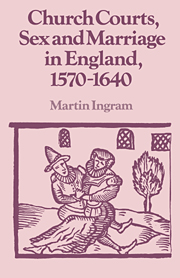Book contents
- Frontmatter
- Contents
- List of tables
- List of maps
- Preface
- Conventions and abbreviations
- Introduction
- PART 1 THE LEGAL AND SOCIAL BACKGROUND
- 1 The structure of ecclesiastical justice
- 2 Economic and social structures
- 3 Religion and the people
- 4 Sex and marriage: laws, ideals and popular practice
- PART 2 SEX AND MARRIAGE: THE PATTERN OF PROSECUTIONS
- PART 3 CHURCH COURTS AND SOCIETY
- Bibliography
- Index
- Past and Present Publications
1 - The structure of ecclesiastical justice
Published online by Cambridge University Press: 24 September 2009
- Frontmatter
- Contents
- List of tables
- List of maps
- Preface
- Conventions and abbreviations
- Introduction
- PART 1 THE LEGAL AND SOCIAL BACKGROUND
- 1 The structure of ecclesiastical justice
- 2 Economic and social structures
- 3 Religion and the people
- 4 Sex and marriage: laws, ideals and popular practice
- PART 2 SEX AND MARRIAGE: THE PATTERN OF PROSECUTIONS
- PART 3 CHURCH COURTS AND SOCIETY
- Bibliography
- Index
- Past and Present Publications
Summary
In the past the church courts have often been viewed in isolation, and hence misjudged. They can, in fact, only be properly understood as part of a much larger system of legal institutions operating in early modern England. To an extent the jurisdiction of the church courts overlapped or was actually in direct competition with other tribunals, while more broadly many of the activities of the spiritual courts invite comparison with those of secular justice. In many ways all legal institutions in this period, whether temporal or spiritual, faced similar difficulties and similar opportunities; and all had to work within a climate of popular opinion which, though largely accepting the rule of law, did not regard the courts and legal practitioners as an unmitigated blessing. It is therefore instructive, before looking specifically at the institutions of ecclesiastical justice, to survey the wider legal context.
The importance of law and legal institutions in the society of Elizabethan and early Stuart England is hard to exaggerate. Government, whether royal, ecclesiastical or seigneurial, was largely channelled through legal forms, and as a result the boundaries between judicial and administrative action were far less clearly drawn than is the case today. To a greater extent than at present, moreover, contemporaries looked to the law not only for the maintenance of order – broadly conceived to include many economic matters, religious observance and personal morality – but also the resolution of conflict within the society.
- Type
- Chapter
- Information
- Church Courts, Sex and Marriage in England, 1570–1640 , pp. 27 - 69Publisher: Cambridge University PressPrint publication year: 1988



